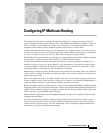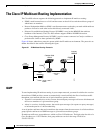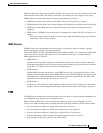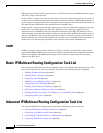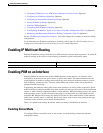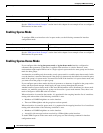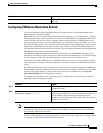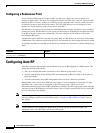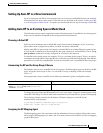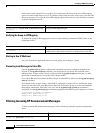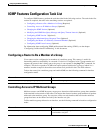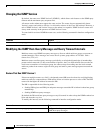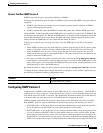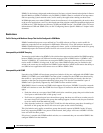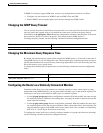
Configuring IP Multicast Routing
Configuring Auto-RP
IPC-406
Cisco IOS IP Configuration Guide
Configuring a Rendezvous Point
If you configure PIM to operate in sparse mode, you must also choose one or more routers to be
rendezvous points (RPs). You need not configure the routers to be RPs; they learn how to become RPs
themselves. RPs are used by senders to a multicast group to announce their existence and by receivers
of multicast packets to learn about new senders. The Cisco IOS software can be configured so that
packets for a single multicast group can use one or more RPs.
The RP address is used by first hop routers to send PIM register messages on behalf of a host sending a
packet to the group. The RP address is also used by last hop routers to send PIM join and prune messages
to the RP to inform it about group membership. You must configure the RP address on all routers
(including the RP router).
A PIM router can be an RP for more than one group. Only one RP address can be used at a time within
a PIM domain. The conditions specified by the access list determine for which groups the router is an RP.
To configure the address of the RP, use the following command on a leaf router in global configuration
mode:
Configuring Auto-RP
Auto-RP is a feature that automates the distribution of group-to-RP mappings in a PIM network. This
feature has the following benefits:
• The use of multiple RPs within a network to serve different group ranges is easy.
• It allows load splitting among different RPs and arrangement of RPs according to the location of
group participants.
• It avoids inconsistent, manual RP configurations that can cause connectivity problems.
Multiple RPs can be used to serve different group ranges or serve as backups of each other. To make
Auto-RP work, a router must be designated as an RP-mapping agent, which receives the
RP-announcement messages from the RPs and arbitrates conflicts. The RP-mapping agent then sends the
consistent group-to-RP mappings to all other routers. Thus, all routers automatically discover which RP
to use for the groups they support.
Note If you configure PIM in sparse mode or sparse-dense mode and do not configure Auto-RP, you must
statically configure an RP as described in the section “Assigning an RP to Multicast Groups” later in
this chapter.
Note If router interfaces are configured in sparse mode, Auto-RP can still be used if all routers are
configured with a static RP address for the Auto-RP groups.
Command Purpose
Router(config)# ip pim rp-address rp-address
[access-list] [override]
Configures the address of a PIM RP.




